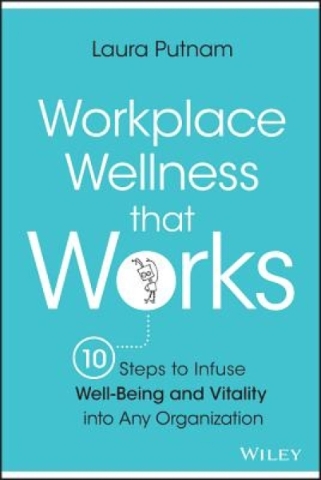
“Workplace Wellness That Works: 10 Steps to Infuse Well-Being and Vitality Into Any Organization” by Laura Putnam (John Wiley & Sons, $35).
Although Putnam focuses on wellness programs for employees, business also suffers from many of the same health problems as their employees — like poor vision, obesity, and fatigue. When a business isn’t healthy, the results can be seen in poor decision making, declining productivity and low morale.
Her 10 imperatives prescribed for creating employee wellness apply to creating business wellness as well.
1. Changemaker — Fess up to the fact your business isn’t healthy. Doing nothing (i.e. maintaining the status quo) won’t cure your ills. Initiate change by explaining why things must change and solicit feedback from employees at all levels. Their input helps identify the unhealthy habits the business has developed and wellness alternatives. It also creates buy-in to the change process.
2. Imagination — With an eye on the alternatives, develop a vision of “becoming our best selves.”.It’s all about “get smarter, get happier, get heathier.”.This “we” approach acknowledges that individual choices impact colleagues and the organization.
3. Culture — The organization’s culture drives the engagement of employees. Examine how the culture must change to support the new vision — especially with respect to processes, decision-making and collaboration. “Gather the stories behind the data.” Solicit feedback and use it to feed forward.
4. Optimism — Fixing what’s wrong starts by building from what’s right. Why? Attitude. Continuing to build on their strengths and input starts the change process on the positive footing, which makes fixes easier to implement. Think in terms of a performance review: If you start with a focus on the negative, employees will feel downtrodden. If you start with their strong points, acceptance of areas needing improvement will come easier.
5. Interdisciplinary — Tear down silos. Common goals require cross-functional solutions. To be effective, collaboration requires the knowledge and appreciation of various perspectives. When teammates learn from teammates better, solutions are thought through and unexpected consequences are minimized. Outside stakeholders must be involved, too.
6. Go Stealth — Salespeople know that the hard sell rarely works. By focusing on what’s important to both the organization and its employees, a needs/benefits construct can be developed. It needs to address the resilience required to change the ways things are done and deemphasize the stress that change may bring about. By emphasizing developmental opportunities, employees will see the challenge and not the newness of doing different things and doing things differently.
7. Engagement — “Behavioral change: Easy to start; hard to sustain.” Success depends upon the “why” people need to embrace change. To motivate, find out what employees care about, and tap into it. There’s no one size fits all.
8. Make it easy; make it normal — Living the new culture involves walking the talk. Be a role model. Others will follow your cues and synch with the new normal. When it comes to spending money when times are tough, make it easier for people to do their jobs. Technology and proximity to interaction come to mind.
9. Experimentation — “It’s the often messy but productive heart of creativity, innovation, and, ultimately, success.” When it comes to initiating change, there’s no way it can be successful coming out of the gate. Launch, then iterate. Learn by doing and make adjustments. The iterative process will get employees engaged because you’ll need feedback to develop the next iteration, and their willingness to execute it.
10. Go global — The Cloud provides businesses with a way to share best practices. Don’t limit your search for answers to those in your industry. Find other sources who found answers to your questions and adapt them to your situation.
Key takeaway: “Start the Movement, Build the Movement, Make it Last.”
Jim Pawlak is a nationally syndicated reviewer of business books.







